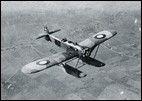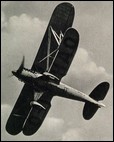
|
Heinkel He 1 1923 |
Three-seat low-wing monoplane floatplane designed by Ernst Heinkel but produced under licence in Sweden for the Navy as the Svenska ... read more ... |
The Heinkel He 2 represented an improvement on the He 1 and underwent considerable testing before it was licence-built in ... read more ... |
Heinkel He 2 1923 |
 |

|
Heinkel He 4 1926 |
Three-seat reconnaissance monoplane, developed from the He 1 and powered by 268kW Rolls-Royce IX . The He 4 was licence-built ... read more ... |
Three-seat reconnaissance monoplane, developed from the He 1 and powered by 335kW Napier Lion engine. The He 5 was licence-built ... read more ... |
Heinkel He 5 1926 |
 |

|
Heinkel He 8 1927 |
The He 8 was a two/three-seat reconnaissance floatplane powered by a 335kW Armstrong Siddeley Jaguar radial engine. It was a ... read more ... |
The He 46 of 1931 was a two-seat armed reconnaissance and army cooperation parasol-wing monoplane, powered in its production form ... read more ... |
Heinkel He 46 1931 |
 |

|
Heinkel He 59 1931 |
The He 59 first appeared in 1931 and was a large twin-float biplane powered by two 492kW BMW VI engines. ... read more ... |
The He 45 was the first of Heinkel's combat aircraft proper for the Third Reich. At the time of its ... read more ... |
Heinkel He 45 1931 |
 |

|
Heinkel He 50 1932 |
The He 50 was a
484.4kW Bramo 322B-engined single-seat dive-bomber and two-seat reconnaissance biplane of 1931, production examples of which went ... read more ... |
Ernst Heinkel, chief designer of Hansa Brandenburg for a number of years, was responsible for the creation of several significant ... read more ... |
Heinkel He 51 1932 |
 |

|
Heinkel He 63 1932 |
The first prototype flew in 1932. There were two modifications:
the land based He-63L and the float plane He-63W. ... read more ... |
Two-seat sporting and training monoplane powered by a 112kW Argus As 8R inverted engine. Both cockpits were completely enclosed by ... read more ... |
Heinkel He 64 1932 |
 |

|
Heinkel He 60 1933 |
The He 60 entered production in 1933 as a two-seat short-range armed reconnaissance biplane and trainer, .powered by a 492kW ... read more ... |
Like a number of German aircraft which were designed and built in the 1930s, the He 111 was planned from ... read more ... |
Heinkel He 111 1935 |
 |
Developed in 1936 as a mailplane for Deutsche Lufthansa, the Heinkel He 116 made use of design features of the ... read more ... |
Heinkel He 116 1937 |
 |
Designed as a replacement for the very successful Messerschmitt Bf 109, the He 100 failed to win production orders. Nevertheless ... read more ... |
Heinkel He 100 1938 |
 |
Single-seat experimental aeroplane powered by a 5.89kN Walter HWK-R1 203 rocket motor. First flown on 20 June 1939. read more ... |
Heinkel He 176 1939 |
 |

|
Heinkel He 178 1939 |
This aircraft is assured a distinguished place in aviation history: on 27 August 1939, piloted by Flugkapitan Erich Warsitz, it ... read more ... |
Potentially one of the Luftwaffe's most effective night-fighters, the Heinkel He 219 Uhu (owl) was another aircraft which suffered from ... read more ... |
Heinkel He 219 "Uhu" 1942 |
 |
The He 111Z (Zwilling, or twin) combined two He 111H-6 airframes, joined by a new wing centre-section to mount a ... read more ... |
Heinkel He 111Z 1943 |
 |
| 
